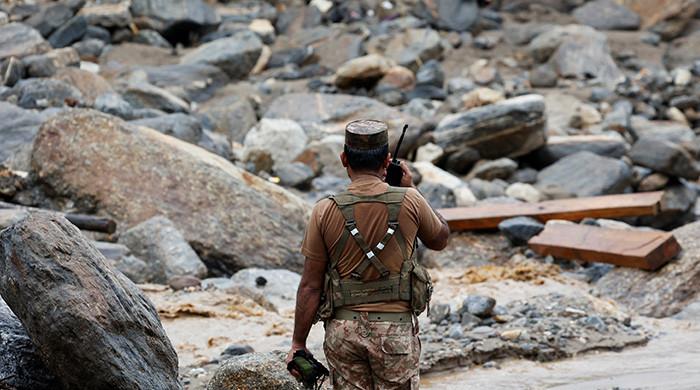- The army releases blocked roads, restore access to Shangla, Buner.
- The NDMA reports 660 deaths nationwide during the monsoon rains in progress.
- KP universities closed from August 19 to 25 in the flood risks.
Islamabad / Peshawar: Rescue and rescue operations are starting to count in the districts struck by the floods of Khyber Pakhtunkhwa while the Pakistani army engineers work 24 hours a day to clean the blocked roads and restore access to stranded residents after the flood and the landslides were wreaking havoc in the province.
The staff of the army engineers reopened the bypass of Pir Baba for all kinds of traffic and released from debris in the Pir Baba bazaar overnight to facilitate the local population in the Biner district.
In addition, the road leading to the village of Gokand in Buner was released at three points after heavy landslides, while the Aluch – Poran road was also restored with the help of heavy machines.
Urban research and rescue teams, helped by heavy equipment, continue to carry out operations in Bishoni and Qadir Nagar. Until now, five bodies have been recovered in a stream near Bishoni. The soldiers promised to continue rescue operations until full restoration in all areas affected by floods.
Sudden floods triggered by heavy rains and explosions of clouds have killed at least 341 people in KP since Friday, according to the province of disaster management, a bun emerging as the most affected district, where more than 200 lives were lost. The rescuers encountered difficulties in moving heavy machines in narrow streets, slowing operations more.
The National Disaster Management Authority (NDMA) reported that the torrential and flooded rains this monsoon season had killed at least 660 people across the country since the end of June. KP recorded the highest deaths at 392, followed by Punjab with 164, Gilgit Baltistan with 32, Sindh with 29, Balutchistan with 20, officials have said clouds – a rare phenomenon where more than 100 mm of rain fall in an hour – Trémail alone.
A general devastation was also reported in Peshawar, Mardan, Swabi and Abbottabad. In Swabi, at least 11 people died in sudden floods on Monday. In all hilly regions, houses, buildings, vehicles and personal effects have been swept away.
The President and CEO of the NDMA, General Inam Haider Malik, warned against two other potential rain spells between August 21 and September 10, warning that new explosions of clouds “could intensify” the disaster.
More widespread rain to strike parts of the country
Meanwhile, the Pakistan Meteorological Department (PMD) has more generalized rainy wind / Thunders through the Khyber Pakhtunkhwa, Punjab, Sindh, Baloutchistan, Kashmir, Gilgit-Baltist and Islamabad on Tuesday. Strong to very strong precipitation is expected in several regions, which increases the risk of sudden floods in draws and streams, in particular KP, Kashmir, Gilgit-Baltistan, the Potohar region, Dera Ghazi Khan, Koh-E-Suleman and northeast of Balutchistan.
The PMD warned that urban floods could strike low northeast areas of Punjab, Islamabad / Rawalpindi, Peshawar, Nowshera and South-Est Sindh. The landslides are also feared in vulnerable hilly areas, notably Mirurée, Galliyat, Cashmire, KP and Gilgit-Baltistan. Strong winds, lightning and torrential showers can damage weak structures such as mud houses, display panels, solar panels and electric posts, added the notice.
In the past 24 hours, the heavy rains have already beat several parts of the country. Rawalakot recorded 110 mm, Murrier 888 mm, 84 mm chakwal, Takht Bhai 80mm and Peshawar Airport 54mm. Meanwhile, the Dalbandin and the Turbat were the hottest at 43 ° C, followed by Nokundi at 42 ° C.
KP universities close in the middle of heavy rains
In response to the worsening of the weather situation, the Khyber Pakhtunkhwa Higher Education Department announced the closure of all the colleges and universities of the Comptoir de la Zone from August 19 to 25. The decision, according to an official notification, was made to protect the life of students, teachers and staff in the risks of clouds, lightning floods and landslides.
The department ordered institutions to continue academic activities via online platforms during closure. The provincial Minister of Higher Education, Meena Khan Afridi, said that the government also provided for rescue measures in the higher education sector to ensure that students are not confronted with difficulties or disruptions in their studies due to floods.
The KP Higher Education Department has also published an evaluation report for the damage of colleges and universities affected by floods. According to the report, the limited wall of 300 feet of the Lalqila government diploma college in Lower Dir was carried away, while the water supply scheme and the tube well of the Wari diploma government in Upper Dir were damaged.
In Shangla, the 3,000 feet limited wall of the Chakisar College collapsed. Similarly, the border wall of the Government’s third cycle college in Saidu Sharif, Swat, was also damaged, while the Government Degree College Shamozai in Swat has lost part of its wall against floods.
At the University of Shangla, a 1,400 -foot water pipeline was damaged, while the CHARBAGH campus of the University of Swat, a limit wall of 40 feet collapsed. The report also noted that the limit wall of the residential colony of the University of Swat was also affected.
Government response
Federal and provincial leaders have promised support for rescue efforts. The chief minister of KP, Ali Amin Gandapur, announced the wages of wages – a month’s salary of the CM, 15 days of members of the cabinet, seven days from the provincial legislators, two days before the officers of 17th year and more, and one day of lower staff.
Prime Minister Shehbaz Sharif also promised full support from the federal government, donating a month’s wages from the federal cabinet to help affected communities.
Federal Minister of Climate Musadik Malik assured that all the roads would be reopened within 24 hours, the center working “without discrimination” alongside provincial governments.
The landslides and the sudden floods are a recurrent characteristic of the Pakistani season of the monsoon, which generally begins in June and shrinks at the end of September. The rains bring southern Asia about three -quarters of its annual water supply, crucial for agriculture and food security, but they also leave a trace of destruction.
According to the chief meteorologist, Zaheer Babar, the country is experiencing an increase in the frequency and intensity of extreme weather events. He explained that strong showers in the mountains often turn into sudden floods downstream, catching residents in low -abounded areas.
Babar noted that climate change is a key factor that stimulates this volatility, but human practices aggravate the impact. The houses built along the banks, the restricted navigable waterways and the waste restriction of the natural flow of rainwater, amplifying devastation.
Pakistan remains among the most vulnerable countries in the world in the world, beaten several times by extreme weather conditions. In 2022, monsoon floods overwhelmed a third of the country and made around 1,700 lives, stressing the extent of the challenge.
– with an additional reuters input and the application




